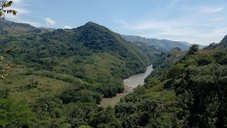LandTrop | Landscape Evolution in the Tropical Andes
Drivers of landscape evolution across multiple spatial and temporal scales in northwestern South America.

The landscape evolution of the Colombian Andes during the Cenozoic was shaped by the interaction between several oceanic plates and the continental margin of South America. Such a dynamic convergent system, involving the accretion of oceanic terranes and subduction tectonics, resulted in a highly asymmetric topographic growth of the Colombian Cordilleras. This project aims to study the drivers of the spatial and temporal heterogeneity of mountain building and basin development in the northwesternmost Andes. We combine field-based structural and geomorphological observations with sedimentological and geo-thermochronological data to reconstruct the timing and rates of landscape evolution. Our main goal is to better understand the linkages between tectonics, volcanism, and climate-modulated surface processes.
Funding agency
Alexander von Humboldt Foundation – Georg Forster Fellowship (S. León)
GFZ PoF-Expedition 2024, 2025.
Cooperations
Hella Wittmann-Oelze (GFZ), Ethan Conrad (UCL), Mauricio Parra (USP, Brazil), Andrés Cárdenas (EAFIT, Colombia), Víctor Valencia (WSU, USA), Carlos Jaramillo (STRI, Panama)
Publications
León, S., Faccenna, C., Conrad, E.M., Parra, M., Cárdenas, A., Valencia, V.A. (2025). The role of transpressional tectonics, volcanism, and fluvial processes on the Oligocene to Pliocene evolution of intermontane basins of the western Colombian Andes. Tectonics 44, e2024TC008461. https://doi.org/10.1029/2024TC008461
León, S., Parra, M., Marulanda, U.M., Monsalve, G., Jaramillo, C., Vallejo, D.F., Valencia, V.A. (2025). Tectonostratigraphic evolution of a marginal basin during the transition from arc-collision to subduction: The case of the northern Pacific forearc of Colombia. Geol. Soc. Am. Bull. 137, 790–809. https://doi.org/10.1130/B37612.1